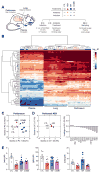Antibiotic-Induced Changes to the Host Metabolic Environment Inhibit Drug Efficacy and Alter Immune Function
- PMID: 29199098
- PMCID: PMC5730482
- DOI: 10.1016/j.chom.2017.10.020
Antibiotic-Induced Changes to the Host Metabolic Environment Inhibit Drug Efficacy and Alter Immune Function
Abstract
Bactericidal antibiotics alter microbial metabolism as part of their lethality and can damage mitochondria in mammalian cells. In addition, antibiotic susceptibility is sensitive to extracellular metabolites, but it remains unknown whether metabolites present at an infection site can affect either treatment efficacy or immune function. Here, we quantify local metabolic changes in the host microenvironment following antibiotic treatment for a peritoneal Escherichia coli infection. Antibiotic treatment elicits microbiome-independent changes in local metabolites, but not those distal to the infection site, by acting directly on host cells. The metabolites induced during treatment, such as AMP, reduce antibiotic efficacy and enhance phagocytic killing. Moreover, antibiotic treatment impairs immune function by inhibiting respiratory activity in immune cells. Collectively, these results highlight the immunomodulatory potential of antibiotics and reveal the local metabolic microenvironment to be an important determinant of infection resolution.
Keywords: LC-MS/MS; antibiotic; germ-free; immunomodulation; metabolic environment; metabolomics; phagocytosis; respiration; systems biology.
Copyright © 2017 Elsevier Inc. All rights reserved.
Figures






Similar articles
-
Antibiotic efficacy is linked to bacterial cellular respiration.Proc Natl Acad Sci U S A. 2015 Jul 7;112(27):8173-80. doi: 10.1073/pnas.1509743112. Epub 2015 Jun 22. Proc Natl Acad Sci U S A. 2015. PMID: 26100898 Free PMC article.
-
Erythropoietin Promotes Infection Resolution and Lowers Antibiotic Requirements in E. coli- and S. aureus-Initiated Infections.Front Immunol. 2021 Apr 13;12:658715. doi: 10.3389/fimmu.2021.658715. eCollection 2021. Front Immunol. 2021. PMID: 33927725 Free PMC article.
-
Antioxidant supplementation enhances bacterial peritonitis in mice by inhibiting phagocytosis.J Med Microbiol. 2014 Mar;63(Pt 3):355-366. doi: 10.1099/jmm.0.067173-0. Epub 2013 Dec 4. J Med Microbiol. 2014. PMID: 24307637
-
Antibiotic efficacy-context matters.Curr Opin Microbiol. 2017 Oct;39:73-80. doi: 10.1016/j.mib.2017.09.002. Epub 2017 Oct 16. Curr Opin Microbiol. 2017. PMID: 29049930 Free PMC article. Review.
-
Exogenous metabolite feeding on altering antibiotic susceptibility in Gram-negative bacteria through metabolic modulation: a review.Metabolomics. 2022 Jul 4;18(7):47. doi: 10.1007/s11306-022-01903-w. Metabolomics. 2022. PMID: 35781167 Review.
Cited by
-
Nanotherapeutics with immunoregulatory functions for the treatment of bacterial infection.Biomater Res. 2023 Jul 22;27(1):73. doi: 10.1186/s40824-023-00405-7. Biomater Res. 2023. PMID: 37481650 Free PMC article. Review.
-
Western Diet and Psoriatic-Like Skin and Joint Diseases: A Potential Role for the Gut Microbiota.J Invest Dermatol. 2021 Jul;141(7):1630-1632. doi: 10.1016/j.jid.2021.01.003. J Invest Dermatol. 2021. PMID: 34167722 Free PMC article.
-
Transfer learning predicts species-specific drug interactions in emerging pathogens.bioRxiv [Preprint]. 2024 Jun 6:2024.06.04.597386. doi: 10.1101/2024.06.04.597386. bioRxiv. 2024. PMID: 38895385 Free PMC article. Preprint.
-
Persistence of Intracellular Bacterial Pathogens-With a Focus on the Metabolic Perspective.Front Cell Infect Microbiol. 2021 Jan 14;10:615450. doi: 10.3389/fcimb.2020.615450. eCollection 2020. Front Cell Infect Microbiol. 2021. PMID: 33520740 Free PMC article. Review.
-
Metagenomic Analysis Reveals the Distribution of Antibiotic Resistance Genes in a Large-Scale Population of Healthy Individuals and Patients With Varied Diseases.Front Mol Biosci. 2020 Oct 30;7:590018. doi: 10.3389/fmolb.2020.590018. eCollection 2020. Front Mol Biosci. 2020. PMID: 33330625 Free PMC article.
References
-
- Andrews JM. Determination of minimum inhibitory concentrations. J Antimicrob Chemother. 2001;48(Suppl 1):5–16. - PubMed
-
- Anuforom O, Wallace GR, Piddock LV. The immune response and antibacterial therapy. Med Microbiol Immunol. 2015;204:151–159. - PubMed
-
- Ballabio D, Consonni V. Classification tools in chemistry. Part 1: linear models. PLS-DA. Anal Methods-Uk. 2013;5:3790–3798.
MeSH terms
Substances
Grants and funding
LinkOut - more resources
Full Text Sources
Other Literature Sources
Medical

